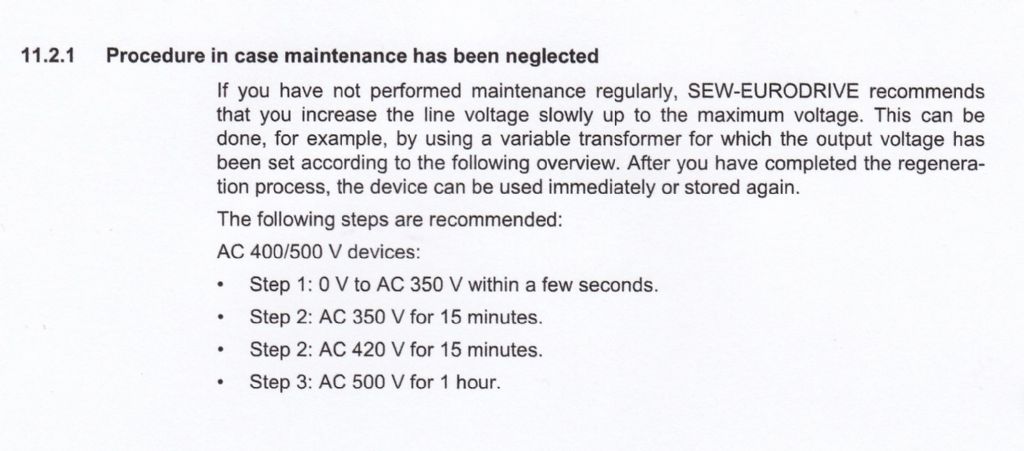Having been in electronics for 40 years or so, mainly military, but quite a bit of industrial electronics as well, power supplies in the 10's of KW range, dc-dc and AC invertors, etc, I have in all that time NEVER had an electrolytic explode due to reforming requirements. Military stock often sits in stores for years, esp large power supplies that would run off 400Hz 3 phase 115volts, big electrolytics after the recifiers, etc. I have bought up surplus VFD from factory closedowns and stored many of them ( a few dozen in fact) for 6 years if not longer, and they just work on power on. Not to say what has been said in posts here is not valid, but I am not sure this should be a rush to the Health and Safety Gods…These components are generally in an enclosure, the VFD case, etc, so not really a bomb in your briefcase..If however you are working on the bench with the unit open, then common sense applies – you do not need a Health and Safety pamphlet/officer/MEW reminder, etc, when machining on your lathe, do you? And it is no more safe than Electricity on your bench…
That said, I have had MANY electrolytic explosions and in every case this has been due to poor capacitor rating for the job. Savings in production ensure dumb choices as to capacitor working voltage and ripple current capabilities, the two main killers of electrolytics. The third killer is temperature of working environment. Many of the larger electrolytics have a small rubber valve which allows excess pressure to escape. Most electrolytics have a wet or gel electrolyte, and with the escaping pressure goes some of this 'wetness' – excess temp or high ripple currents causing high temps will help the capacitor dry out, resulting in its Farad value decreasing drastically. High ripple currents also generate heat which does not help.
Electrolytics without the small rubber bung still release gases through the base of a radial connection type, and through the positive connection end of a axial connection type – both constructions have rubber insulation seals which vent.
Capacitor re-forming is normally applied to regenerate the capacitor back close to its nominal capacitance value, and this by default will permit the specified ripple current to be handled.
I mentioned the importance of capacitor working voltage – Generally the capacitor specified voltage should be about 20 to 30% higher than the max applied voltage. This ensures suitable inner plate arcing prevention, and appropriate plate oxide maintenance. It is folly to use an electrolytic of greater than 100% more than the applied voltage in an industrial application ( such as in a VFD) – Oxide maintenance is reduced over time, and the capacitor value reduces, as does its ripple current capability. It will eventually fail as will one with too low a voltage rating. You will note that in 230V mains rectifiers, the smoothing capacitor is normally rated at 400VDC – below the 100% limit.
As to SillyOldDuffers comments on the explosions not being dangerous – everything is or isn't dangerous, just be careful, and use common sense. Legislating it dangerous won't stop it from killing you, nor will pages of H&S gumph all over the place. That's why folk don't experiment and toy anymore – they are not allowed to or are too scared…
By the way, the small electrolytics (say up to 15mm diameter or so) are quite dangerous when they explode un-restrained. The case is small, but the aluminium wall thickness cannot easily be scaled down per the case size, so the case rarely splits – for a radial lead device, it just pulls off the rubber base bung and shoots out behaving like a bullet. Watch out for those…
Abused Tantalum capacitors, on the other hand, rarely lose capacitance or dry out or behave normally – they just become a low impedance or short circuit and burn up everything around them..This happens very quickly by exceeding its working voltage by even 5%….
My diatribe gives no advice as to reforming capacitors – have just never needed to do it, not even on an Old Phantom 3phase 115 VAC to DC supply to the cannons after 20 years in the store…..
Joe
edits to fix damn typo's
Edited By Joseph Noci 1 on 14/03/2018 09:19:45
SillyOldDuffer.





